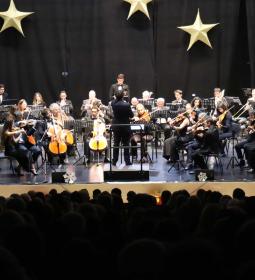The work of Professor José Vicente Cabezuelo, with the title 'Formation and decline of the lordly state of Bernat de Sarrià in the Kingdom of Valencia', was presented yesterday at the Torrejó
A book about the lordship of Bernat de Sarrià offers a geohistorical map of the Marinas in the 13th and 14th centuries

Yesterday afternoon, the Municipal Center of Torrejó hosted the presentation of the book 'Formation and Decline of the State of Bernat de Sarrià in the Kingdom of Valencia. (End of the 13th century - 1335)', a work written by the professor of Medieval History at the University of Alicante, José Vicente Cabezuelo Pliego. The presentation, attended by Mayor Toni Pérez and several members of the corporation, took place on the fifth floor of the building, with free admission.
The book was presented by Juan Francisco Jiménez Alcázar, professor of Medieval History at the University of Murcia and president of the Spanish Society of Medieval Studies, who together with the author made a profile of both the work and its protagonist, the Valencian nobleman Bernat de Sarria.
The study analyzes the construction of the Bernat de Sarrià manor, the conflicts with the neighbourhood, the rampant indebtedness of the noble's treasury and the process of the transfer of the domain to the infant Pedro, count of Ribagorza, through a series of instruments and managers. financial institutions that allow and supervise it. The legal transition of the lordship from one lord to another offers a geohistorical map of the region known then as Montanea Valencia – the current Marinas – of undoubted wealth, allowing the identification and location of a large number of farmhouses and castles, as well as a more exact knowledge of the organization of settlement, cultivation spaces and taxation. Likewise, through the documentation consulted, traces of the psychological and human profile of the character that is the theme of the book are inferred and revealed about intelligence, skills, attitudes and behavioural patterns.
The author indicated that he had put “a lot of effort” into the book, which he said is “a mixture of work, gratitude and luck” after spending 35 years working behind the character of Bernat de Sarrià and after an “arduous and often very complicated research work.”
Cabezuelo explained that Bernat de Sarrià “lived the tensions of the Valencian Muslims, the Mediterranean expansion of the crown of Aragon, the Murcia war and its incorporation into the crown of Aragon, etc., and in all these episodes he actively participated” . In his opinion, he can be presented “as a statesman because he is possessed of great political acuity and with a cultural and literary background that is seen in a diplomatic role. But above all, he is a military man.”
The book portrays a character who is “unscrupulous, eager for money, without limits in his excesses in war, with a harsh and difficult character, a private life full of ups and downs and a faithful fulfiller of his duties as a Christian.” ”. Bernat de Sarrià “was not born a nobleman,” but he became a person of the utmost trust of the kings he served, especially James II “of whom he was his main advisor.”
Regarding his possessions, Cabezuelo stated that he built “a vast manor south of the Júcar River and managed to amass a rich heritage that was alien to his lineage after his death” as a consequence of debts due to his poor ability as a manager of his assets. The book reflects on the creation and decomposition of that lordship that “was not built by a lineage but by a person over three decades.” For this, the main formulas used were “donations and acquisitions through purchases.” “From a small castle in Confrides he took over the entire Marina Baixa and Alta and expanded the demographics with the founding of new towns such as Benidorm or La Vila Joiosa” noted the author.
José Vicente Cabezuelo also revealed Bernat de Sarriá's friendship with the Infante Don Juan Manuel, grandson of Fernando III, and his “infinite hatred” of Roger de Lauria.
Mayor Toni Pérez, who closed the presentation, said that Bernat de Sarriá “was a character in every sense,” but clarified that “we cannot judge the facts or the people with today's vision and values.” Pérez indicated that "now we have a much more exact approximation and we can learn" and added about the protagonist of the work that "our entire mountain has some reference to Bernat de Sarriá."
The mayor considered that the book "will be an interesting look at the character who created us as a town and who began bringing water with the construction of ditches" although he specified that the arrival of water "was consolidated 300 years later with Beatriu Fajardo, who “He also brought a second Carta Pobla.”
Finally, the mayor announced that when next year the 700 years of the founding of Benidorm would be celebrated "We want to hold an important seminar with the participation of the University of Alicante, the University of Murcia and the Spanish Society of Medieval Studies, included among the events that are organized on the occasion of this anniversary, to have an unbeatable academic poster.”












